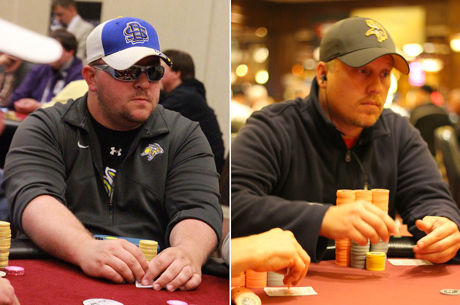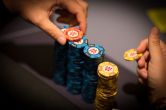Learning to Think About Your Own Range of Hands, Part 1

In poker we only get to play one hand at a time. As a result, we typically find ourselves asking "How should I play this hand, on this street?"
When we do so we're going to encounter some spots where we simply have no idea what to do — because we don't understand our own range of possible hands.
I played a hand in the World Poker Tour National Killarney event last weekend that shows how thinking about your whole range of hands can guide decisions throughout postflop with any particular hand.
It was before the money, With a stack of 19 big blinds, I min-raised the button with AxQx-offsuit, and the big blind — a big stack — defended with a call. The flop came 10x9x8x and my opponent checked.
When considering this first real decision in the hand, we should recognize that in this flop situation, my betting frequency is very low both in theory and in practice. Sure, I would love simply to bet and get a fold. But there are more hands than just AxQx that might be tempting to bet with to win the pot, to get value, or to gain protection.
Don't leave your checking range hanging
There are hands on this flop with which you might be tempted to bet because you can get value or protection. There are also hands on this flop you want to check because putting in money will diminish their strength and they don't mind seeing another card. But if you always bet the former and check the latter, you're going to run into problems.
For example, those "clear" checks need to be protected from our opponent's turn and river bluffs, and that can be done in part by also checking those hands you want to bet. We also solve a problem of losing the equity a hand like AxQx or Ax9x has on this flop when betting them and getting raised (and then having to fold).
Here is an illustration of the problem with the weak checking range. Say we always bet strong hands like sets and two-pair hands on the flop, and check weaker ones. Then after we check the flop, the turn pairs the board.
If the big blind bets four big blinds into the roughly six-BB pot, we call, then our opponent shoves 13 big blinds into a 14-BB pot on the river, which could be an undercard or another board pair. By then we won't often have a strong enough hand to call again. Or rather, we won't have a strong enough hand to call often enough.
Thus by checking would-be flop bets like 8x8x, we protect flop checks like Qx8x.
A continuing range for all sizes
If we check the pot is a little under 6 BBs, and we still have 17 BBs behind. We can then manage any bet size our opponent might throw out, on any card.
If the player bets huge on a Jx turn, we can call with our top two pairs, our sets, and our straights. If our opponent bets not huge but a decent size on a Jx turn, we can add some pair plus gutshot or straight draws like KxJx, QxJx, Qx10x, KxKx, and so on as their bet size decreases.
The point is we have our whole range to consider — not just the specific hand we're playing — and we should just draw a line based on the size our opponent bets and the strength of the various hands on the particular turn card. For example, if an 8x came on the turn, the ordering of our range's strength will be different, but we will also narrow it down according to our opponent's bet size.
A continuing range for all cards
If we have a checking range on the flop that includes gutshots, open-enders, two-pair hands, sets, and overcards, our flop check range will include the nuts on the river on all conceivable turn-river combinations.
In this way we cannot be bluffed by the big blind betting big twice. If the turn and river are both blanks — say, a 2x and a 4x — we checked the flop with a range including QxJx, Jx7x, 7x6x, 9x9x, and so on. In other words, we have a range that includes all the strongest hands on this runout, and we can simply decide how far down the line we should call or fold our river range.
But if we checked the flop with KxQx, Qx8x, and Qx9x as well, then on a Jx river we will also have the strongest hands.
So in summary, when it blanks out, the presence of QxJx and other strong hands in our range allows us to fold Ax9x comfortably to a turn bet and river shove from big blind, whereas we can fold 9x9x and 7x6x when a jack comes on the turn or river, because we have so many QxXx hands as well as the occasional KxQx. Our weakest calls are protected by our strongest, while our straight draws are protected by our two-pair hands (and vice-versa).
Looking for clues in our own range
In the actual hand, I checked and the turn came an offsuit 2x, making the full-rainbow board 10x9x8x2x, and my opponent bet 2.5 big blinds.
Again, to be prepared for any river card we need a diverse calling range. If the board changes, we want to have the nuts and strong hands. If it doesn't change, we still want to have the nuts and strong hands. I called with my AxQx — two overcards and a gutshot.
The river card was as interesting as the turn card was not. And again clues in my own range helped to decide how exactly I should play my AxQx. We'll look at the river in Part 2.









